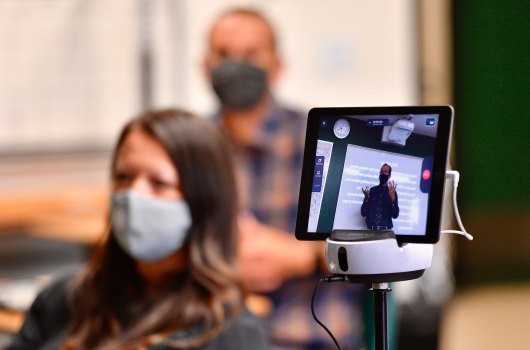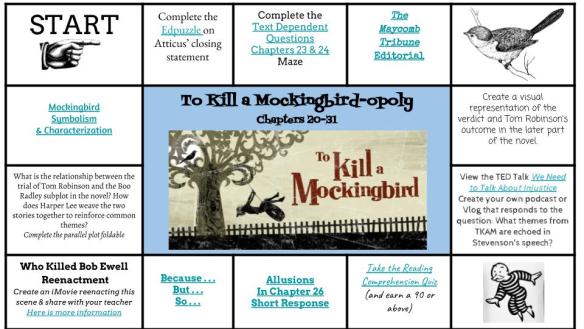How do I teach kids at home and at school at the same time?!?
 If you’re one of the many teachers entering into an unprecedented hybrid learning environment, I am sure this question is top of your mind. For teachers coming out of a remote learning setting, it may be hard to wrap your head around another new classroom approach, and may even feel like you now have to plan for two different classes at the same time.
If you’re one of the many teachers entering into an unprecedented hybrid learning environment, I am sure this question is top of your mind. For teachers coming out of a remote learning setting, it may be hard to wrap your head around another new classroom approach, and may even feel like you now have to plan for two different classes at the same time.
To help you succeed in this new classroom structure, I’ve shared a few ideas on how you can leverage the best of blended learning to plan for ONE blended classroom (on and off screen!) within a hybrid classroom environment. I’ve also included a few video tutorials from the amazing blended learning coaches at LINC to help you get started! Here are three tips to help you plan:
- Flip Your Classroom
It can be easier than you think to record your instruction, using tools like Screencastify, Screencastomatic, or even Zoom and Google Meet. When you record 15 minutes of instruction for your students, they can watch your explanations repeatedly to understand new ideas, or as a review/refresher later in the unit. By splitting your in-person and at home group during a class period, you can have your in-person class watch the video on their devices, while you meet virtually with your at-home students to review and discuss the video (which they can watch earlier in the day- flex scheduling!). Then you can meet with your in- person class while your online group moves on to do other work offline. Here’s a video from LINC coach Kate showing you how to create video screencasts, to help you try this out. Keep in mind that these don’t have to be professional videos. The goal is to share instruction with your students just like you do in class!
- Use Station Rotation to Teach in Small Groups
 Plan instruction around 3-4 small group activities: Small group with the teacher, an online activity, an offline activity, and a partner or small group collaborative activity. Students can participate in each of these activities at home or at school. Here’s how it works!
Plan instruction around 3-4 small group activities: Small group with the teacher, an online activity, an offline activity, and a partner or small group collaborative activity. Students can participate in each of these activities at home or at school. Here’s how it works!
- For small groups, teachers can schedule in-person groups and meet with small groups via Google Meet or Zoom at a scheduled time.
- Online activities can be videos, articles, podcasts, digital curriculum assignments, or online assignments that students complete using digital tools like Google Docs, Slides, Flipgrid, or Padlet.
- Offline assignments might include reading, writing, play/physical activity, or practice assignments. Students at home can take a picture of their work to send it in, or they can record a short video summary of their offline time to share with the teacher.
- Partner and small group collaboration can happen in person or in virtual space using shared docs or video tools like Zoom or Google Meet. To get students working together in real-time or asynchronously in shared docs, use digital tools like Google Docs, Google Slides, Padlet or Flipgrid! Here’s a Padlet board from LINC with ideas for how this can be done! Students can also have scheduled collaborative time in person, at home via Google Meet or Zoom, or a combination of the two. This can be time for discussion, sharing and documenting ideas (on or offline), or even just opportunity for play and socialization.
- Use a Playlist to Share a Week’s Worth of Self-Paced Instruction
 One of the best ways to manage work in person and at home is to create self-paced assignments that students can complete on and offline, using a Playlist structure. This gives you the most flexibility in how and when you work with students and allows you to more directly target the individual needs of your students throughout the day. Here’s how it works:
One of the best ways to manage work in person and at home is to create self-paced assignments that students can complete on and offline, using a Playlist structure. This gives you the most flexibility in how and when you work with students and allows you to more directly target the individual needs of your students throughout the day. Here’s how it works:
- Teachers plan a week’s worth of instruction, including a mix of online work, offline work, and collaborative work, similar to a station rotation.
- Students are given the playlist assignments at the beginning of the week and can work through them at their own pace, individually or collaboratively.
- While students work on assignments from their playlists, teachers are able to deliver instruction as needed, to the whole group, small groups, or 1:1. Students can pause in their playlists at any time, so it is easy for a teacher to review work at the end of one day, and create a small group or 1:1 schedule for the next day, based on a review of student needs.
- Small groups and 1:1 instruction can include in-person and remote students and can be scheduled at any time, because of the flexible schedule a playlist provides.
Playlists can be used to plan a day of instruction, a week of instruction, or a whole unit! Start small and work up as students develop more agency and ability to self-pace, or plan to meet at the beginning, middle, and end of the day with students who may need more direction and/or support. To get started with playlists, or to get additional tips, watch this video from LINC coach Charity.
Try any one of these ideas to help you get started with your hybrid planning, or use a combination of all three through the week. If you find you need more support to get started, our team at LINC has been working throughout this disruptive time to help teachers rapidly learn new tools and strategies to deliver instruction. Join us at LINCspring LIVE! each week as we share hybrid learning tips from the field to help you build your toolbox and support your students. We know you are doing amazing work out there, so keep tinkering and being the innovative, creative teacher your kids need!